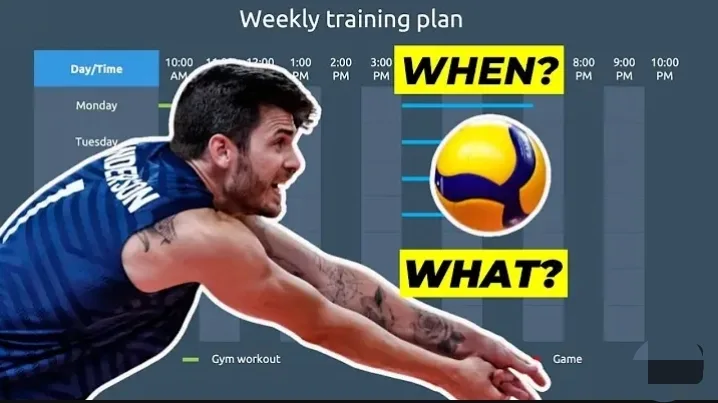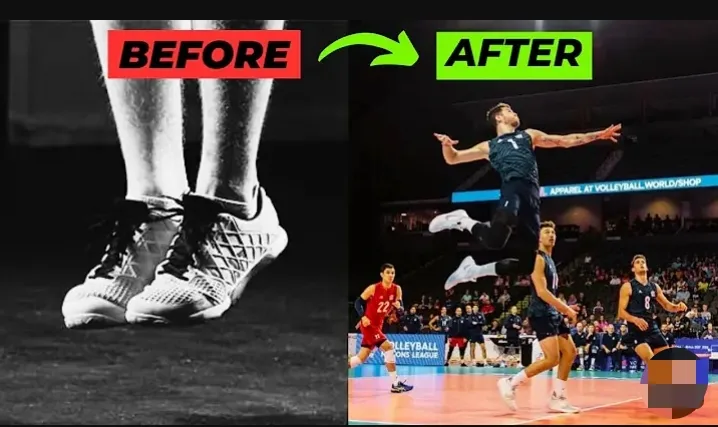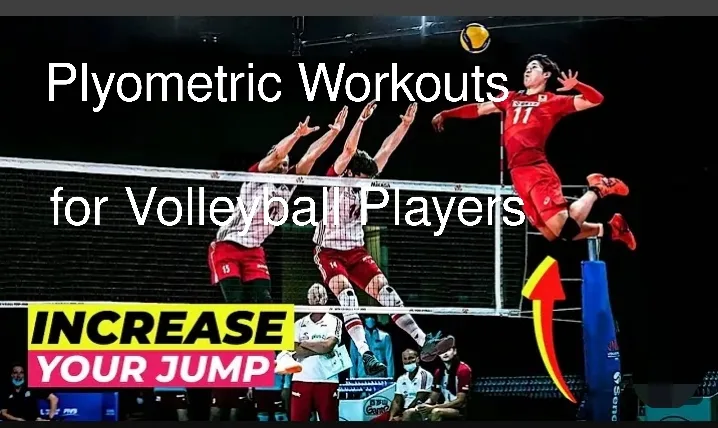A solid volleyball workout plan is essential for any player looking to enhance skills, physical fitness, and mental sharpness. Whether you are aiming to jump higher, improve your agility, or simply enhance your overall performance on the court, a structured workout routine can make all the difference. This guide will walk you through the best volleyball workout plan, weekly schedules, and recovery tips to ensure you’re always at your best.
Why You Need a Volleyball Workout Plan
Volleyball is a physically demanding sport that requires a unique combination of strength, speed, and endurance. A well-designed volleyball workout plan targets all these areas, helping you stay competitive and injury-free. Imagine being able to jump higher for a spike, react faster during a dig, or block with more power—all of this is possible with the right training.
Key components of a volleyball workout plan
Strength Training
Strength training is the backbone of any successful volleyball workout. This involves exercises that focus on building your core, legs, and upper body. Stronger muscles improve your ability to jump, hit, and move quickly across the court.
- Core exercises: planks, Russian twists, and leg raises are great for stabilizing your midsection, which is crucial for balance and power.
- Leg exercises: Squats, lunges, and deadlifts will improve your vertical leap and overall leg strength.
- Upper body exercises: push-ups, bench presses, and rows help build the muscles you need for powerful serves and spikes.
Agility and Speed Training
In volleyball, quick feet and fast reactions can make or break a play. Agility drills, like ladder drills and cone sprints, can dramatically improve your footwork and help you change directions swiftly during a game.
Cardiovascular Conditioning
Endurance is key to lasting through a long match. Cardiovascular conditioning, such as running, swimming, or high-intensity interval training (HIIT), helps improve your stamina so you can stay energized throughout a game without burning out.
Flexibility and Mobility
Flexibility helps prevent injury and improves your range of motion, both of which are crucial for volleyball players. Regular stretching, yoga, or dynamic warm-ups will keep your muscles limber and responsive during matches.
Plyometrics
Plyometric training is all about explosive movements, like jumping. Box jumps, jump squats, and lateral bounds are excellent exercises to improve your vertical leap, an essential skill for both spiking and blocking.
Volleyball Workout Plan
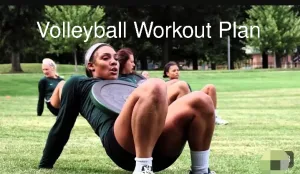
Water Part: 20 Minutes
1. Slow Jog—10 Minutes:
Begin the session with a slow jog to get the blood flowing and prepare the body for more intense exercises. This jog should be at a comfortable pace, focusing on warming up the leg muscles and increasing your heart rate.
2. Warm-Up: 10 Minutes:
This is a critical part of preparing for the workout. The following exercises will help improve mobility and flexibility and prepare the body for explosive movements:
- Walking (on toes, heels): Walk in a straight line first on your toes, then on your heels to engage different muscle groups. This helps strengthen the ankles and calves, important for jumps and quick movements.
- Running, throwing the ball with your fingertips from hand to hand: As you jog lightly, pass the ball between your hands using only your fingertips. This helps warm up your arms and trains control over the ball.
- Walking lunges with ball: Perform lunges while touching the ball to the floor with the leg in front. This will stretch the hips and strengthen your legs.
Ball Exercises: 25 minutes
This set of ball exercises focuses on ball handling, coordination, and body awareness. Each exercise targets a specific skill set necessary for volleyball.
- Run with high knees—2 minutes: Lift your knees high while holding the ball at pelvic level, ensuring the knees touch the ball. This improves your running form and strengthens your lower body.
- From Squat, Throw, and Catch the Ball in a Jump—2 Minutes: Start in a squat position, throw the ball forward and upward, then jump to catch it. This exercise focuses on coordination and explosive movement, which are essential for spiking and jumping.
- Run While Rotating the Ball Around Your Body—2 Minutes: Hold the ball and rotate it around your body while running. This helps improve hand-eye coordination and your ability to handle the ball under pressure.
- Throw the ball over your head, catch after a bounce—2 minutes: Throw the ball over your head, let it bounce off the floor, and catch it. This helps with timing and reaction skills.
- Jumping with Knees to Chest—2 Minutes: Jump straight up, bringing your knees to your chest while holding the ball at waist level. This exercise works on vertical leap strength, which is crucial for blocking and spiking.
- Throw the ball forward and catch in squat position—2 minutes: After throwing the ball forward, squat down and catch the ball before it hits the ground. This combines agility and catching accuracy.
- Walking Lunges While Passing the Ball Under Your Foot—2 Minutes: As you walk in lunges, pass the ball from hand to hand under your leg. This works on flexibility and ball control.
- Run with Straight Legs, Tapping the Ball with Your Toes—2 Minutes: As you run with straight legs, try to tap the ball with your toes, improving foot-eye coordination and flexibility.
Main Part: 1 Hour, 20 Minutes
1. Teaching the Overhead Pass—20 Minutes
This section focuses on the key skill of the overhead pass, an essential element of setting and playing in volleyball. The following drills will improve hand positioning, timing, and accuracy when passing the ball overhead:
- Partner Passing Drill (10 minutes): Each player practices throwing the ball to their partner, who returns it with an overhead pass. After a minute, switch roles. This helps develop accuracy and ball control.
- Overhead Pass with Multiple Contacts (10 Minutes): Start with two overhead passes to yourself, then pass the ball to your partner. The partner does the same, keeping the ball in play as long as possible without catching it.
2. Teaching the Lower Straight Serve—20 Minutes
Serving is one of the most critical aspects of volleyball. This section will focus on developing the proper technique and power for a lower straight serve:
- Serve Technique Practice (5 Minutes): Review and practice the correct foot positioning, hand placement, and ball contact point for a powerful serve.
- Serve Against the Wall (5 Minutes): Stand a few feet away from a wall and aim to hit the ball at a designated height, working on accuracy and form.
- Serve to a Partner (5 Minutes): Pair up and serve the ball back and forth from a distance of 5-6 meters. This helps to refine aim and consistency.
- Serve Over the Net (5 Minutes): Now that you’ve practiced the basics, serve the ball over the net, targeting specific zones on the court for better accuracy.
3. Volleyball Game Rules Overview: 5 Minutes
This brief session will review the essential rules of volleyball, such as:
- Rotation System: Understanding player positions and when to rotate on the court.
- Scoring: Points are scored by grounding the ball in the opponent’s court or when the opponent commits a fault. Rally scoring is used, meaning every rally results in a point for one team.
4. Educational Game: 30 Minutes
After practicing skills, it’s time to apply them in a controlled game environment. Split into teams and play a friendly game, focusing on using the overhead pass and serve techniques learned earlier.
Final Part: 20 Minutes
1. Speed and Strength Development
In volleyball, explosiveness is key. This section focuses on exercises that develop your vertical leap, speed, and strength:
- Long Jump from a Standstill—10 Reps: Jump as far as you can from a stationary position. This improves leg power for jumping and spiking.
- Mixed Stops—20 Reps: Quick changes in direction to mimic the sudden stops and starts during a match.
- Vertical Jumps Near the Net (30 Reps): Jump with one arm raised, simulating the motion of spiking or blocking a ball over the net.
- Jumping Over a Bench (5 Times): Perform quick jumps over a bench to improve your agility and explosive strength.
2. Fun Game: “Don’t Drop the Ball”
Players form a circle and pass the ball to themselves while moving around. The objective is to not let the ball drop while keeping a consistent pace. This game enhances reflexes and ball control in a fun and competitive way.
Cool Down: 10 Minutes
Finish the session with a cool-down, focusing on:
- Full-Body Stretching: Hold each stretch for at least 30 seconds, focusing on the legs, arms, shoulders, and back.
- Deep Breathing: Inhale deeply through the nose and exhale slowly through the mouth to bring the heart rate back to normal.
Here’s how to structure your week with a balanced volleyball workout plan:
- Day 1: Strength Training – Focus on core and leg exercises, such as squats, lunges, and planks.
- Day 2: Plyometrics and Agility: Perform box jumps, ladder drills, and lateral sprints to improve your explosive power and quick movements.
- Day 3: Cardio and Mobility: Include a cardio session like running or cycling, followed by stretching or yoga.
- Day 4: Upper Body Strength: Push-ups, bench presses, and medicine ball throws to build arm and shoulder strength for serves and spikes.
- Day 5: Rest and Recovery: Focus on rest, gentle stretching, and foam rolling to help your muscles recover.
Volleyball-Specific Exercises
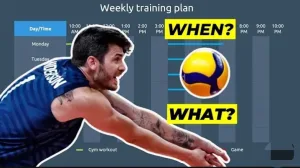
Jumping Drills
Volleyball players need to jump frequently, whether for spikes, blocks, or serves. Exercises like box jumps and jump squats are fantastic for increasing your vertical jump. Aim for 3 sets of 10 reps to improve both power and height.
Serving and Spiking Strength
Building upper body strength through push-ups, shoulder presses, and medicine ball slams will improve your serving and spiking abilities. Stronger arms mean more powerful hits, giving you an edge over opponents.
Blocking Drills
Improve your timing and reach for blocks with exercises like lateral jumps and resistance band work. These drills help simulate the explosive power you need to rise up quickly and meet the ball at the net.
Recovery and Injury Prevention
A great volleyball workout plan doesn’t just focus on training; recovery is equally important. Rest days, stretching routines, and proper nutrition all contribute to better performance and injury prevention.
Rest Days: Allow your muscles to recover by incorporating at least one rest day into your weekly schedule.
Stretching and foam rolling: Use dynamic stretches before training and static stretches afterward. Foam rolling helps release muscle tension and prevents soreness.
Nutrition: Eating a balanced diet rich in protein, healthy fats, and complex carbs will fuel your workouts and aid in recovery.
Frequently Asked Questions (FAQs)
1. How often should I follow this volleyball workout plan?
Ideally, this plan can be followed 2-3 times a week, depending on your current fitness level and volleyball experience. It’s essential to allow time for recovery between sessions to prevent fatigue and injury.
2. What equipment do I need for this workout?
You will need a volleyball, access to a net (or a wall for serving drills), and possibly a bench or horizontal bar for some jumping exercises. Comfortable sportswear and supportive shoes are also recommended.
3. Can beginners follow this workout plan?
Yes! This workout plan is adaptable for beginners. If you’re new to volleyball, focus on mastering the basic drills at a slower pace, and as you get comfortable, gradually increase the intensity.
4. Why is vertical jump training important for volleyball?
Jumping is critical in volleyball for both offense (spiking) and defense (blocking). Training your vertical leap will improve your ability to reach higher, making you more effective at both skills.
5. How do I prevent injuries while following this workout plan?
Warm up properly before starting and cool down after each session. Ensure you’re using the correct technique for all exercises, especially when performing jumps or serves. Listen to your body, and if you feel pain, stop and assess before continuing.
6. What exercises should I focus on in a volleyball workout plan?
A volleyball workout plan should focus on strength, agility, plyometrics, and endurance. Key exercises include squats, lunges, planks, push-ups, and jump drills. These exercises help build the muscle groups used in volleyball—primarily the legs, core, and upper body—while also enhancing speed and flexibility.
7. How often should I follow a volleyball workout plan?
A typical volleyball workout plan can be followed 4-5 days per week. This allows for strength, agility, and conditioning training while giving your body time to recover with rest days. Be sure to include at least one day for active recovery, like light stretching or yoga.
8. Can beginners follow a volleyball workout plan?
Yes, beginners can absolutely follow a volleyball workout plan. Start with basic exercises like bodyweight squats, push-ups, and planks, then gradually increase intensity as you get stronger. Focus on proper form to prevent injury, and consult a coach or trainer if needed.
9. What should I eat to complement my volleyball workout plan?
Proper nutrition is essential for performance and recovery. Your diet should include lean protein (chicken, fish, and tofu), healthy fats (avocados, nuts), and complex carbs (whole grains, fruits, and vegetables). Hydration is also key, so drink plenty of water before, during, and after your workouts.
10. How can I improve my vertical jump for volleyball?
To improve your vertical jump, focus on plyometric exercises like box jumps, jump squats, and lateral bounds. Strength training for your legs, especially with squats and lunges, will also help. Consistency is key, so include these drills in your volleyball workout plan at least twice a week.
By following a structured volleyball workout plan, you’ll see improvements in your strength, agility, and overall performance. Stick to it, stay consistent, and you’ll be a force to be reckoned with on the court!

